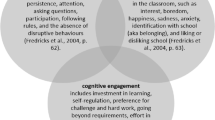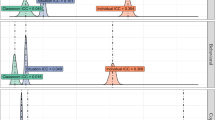Abstract
Science education researchers have found that instructional design focusing more on learners’ affective needs can be powerful in nurturing effective and exciting science learning. This paper reports a qualitative study exploring how learners’ situational affective experiences are influenced by the interplay of their habitual affective attributes and classroom learning environment. The research method adopted was semi-structured in-depth interview. The study is descriptive and retrospective in nature. Nine pre-service teachers who were taking a science method course at an Australian university took part in the study voluntarily. Each interview lasted about 1 h. Six types of interplay were identified: Self-sustained, Beyond expectation, Resonant, Adversely Overpowered, Below expectation and Irresponsive. Implications for science teaching and science teacher education are discussed in terms of the identified types of interplay.
Similar content being viewed by others
References
Aikenhead, G., & Michell, H. (2011). Bridging culture—Indigenous and scientific ways of knowing nature. Toronto. Canada: Pearson.
Ainley, M., & Ainley, J. (2011). Student engagement with science in early adolescence: The contribution of enjoyment to learners’ continuing interest in learning about sciences. Contemporary Educational Psychology, 36(1), 4–12.
Ainley, M., Corrigan, M., & Richardson, N. (2005). Students, tasks, and emotions: Identifying the contribution of emotions to learners’ reading of popular culture and popular science texts. Learning and Instruction, 15, 433–447.
AITSL (2014). Australian professional standards for graduate teachers. Retrieved from http://www.aitsl.edu.au/australian-professional-standards-for-teachers/standards/list. Accessed 15 Oct 2018.
Alsop, S., & Watts, M. (2003). Science education and affect. International Journal of Science Education, 25(9), 1043–1047. https://doi.org/10.1080/0950069032000052180.
Anderson, A., Hamilton, R. J., & Hattie, J. (2004). Classroom climate and motivated behaviour in secondary school. Learning Environments Research, 7, 211–225.
Boe, M. V., Henriksen, E. K., Lyons, T., & Schreiner, C. (2011). Participation in science and technology: Young people’s achievement-related choices in late-modern societies. Studies in Science and Education, 47(1), 37–72. https://doi.org/10.1080/03057267.2011.549621.
Braun, V., & Clarke, V. (2006). Using thematic analysis in psychology. Qualitative Research in Psychology, 3, 77–101. https://doi.org/10.1191/1478088706qp063oa.
Brophy, J. (1987). On motivating students. In D. Berliner & B. Rosenshine (Eds.), Talks to teachers (pp. 201–245). New York, NY: Random House.
Bulunuz, M., Jarrett, O. S., & Martin-Hansen, L. (2012). Level of inquiry as motivator in an inquiry methods course for preservice primary teachers. School Science and Mathematics, 112(6), 330–339.
Convert, B. (2005). Europe and the crisis in scientific vocations. European Journal of Education, 40(4), 361–366.
Dorman, J. P., & Fraser, B. J. (2009). Psychological environment and affective outcomes in technology-rich classrooms: Testing a causal model. Social Psychology of Education, 12, 77–99.
Education Council (2015). National STEM school education strategy, 2016–2026. Retrieved from http://www.educationcouncil.edu.au/site/DefaultSite/filesystem/documents/National%20STEM%20School%20Education%20Strategy.pdf. Accessed 15 Oct 2018.
Fawcett, J., & Downs, F. (1986). The relationship of theory and research. Norwalk, CT: Appleton Century Crofts.
Fortus, D. (2014). Attending to affect in science education. Journal of Research in Science Teaching, 51, 821–835. https://doi.org/10.1002/tea.21155.
Foster, E. (2010). A new equation: How encore careers in math and science education equal more success for students. Washington, D.C: National Commission on Teaching and America’s Future.
Franke, G., & Bogner, F. X. (2013). How does integrating alternative conceptions into lessons influence pupils’ situational emotions and learning achievement? Journal of Biological Education, 47(1), 1–11. https://doi.org/10.1080/00219266.2012.716777.
Fraser, B. J. (1981). Test of science related attitudes (TOSRA). Melbourne, Australia: Australian Council for Educational Research.
Fraser, B. J. (2012). Classroom learning environments: Retrospect, context and prospect. In B. J. Fraser, K. G. Tobin, & C. J. McRobbie (Eds.), Second international handbook of science education (pp. 1191–1239). Dordrecht, The Netherlands: Springer.
Fraser, B. J., Anderson, G. J., & Walberg, H. J. (1982). Assessment of learning environments: Manual for learning environment inventory (LEI) and my class inventory (MCI) (third version). Perth, Australia: Western Australian Institute of Technology.
Fraser, B. J., Nash, R., & Fisher, D. L. (1983). Anxiety in science classrooms: Its measurement and relationship to classroom environment. Research in Science and Technological Education, 1, 201–208.
Fraser, B. J., Giddings, G. J., & McRobbie, C. J. (1995). Evolution and validation of a personal form of an instrument for assessing science laboratory classroom environments. Journal of Research in Science Teaching, 32, 399–422.
Glaser-Zikuda, M., Fub, S., Laukenmann, M., Metz, K., & Randler, C. (2005). Promoting learners’ emotions and achievement—Instructional design and evaluation of the ECOLE-approach. Learning and Instruction, 15, 481–495.
Hascher, T. (2010). Learning and emotion: Perspectives for theory and research. European Educational Research Journal, 9(1), 13–28.
Hattie, J.A.C. (2003). Teachers make a difference: What is the research evidence?. Paper presented at the Building Teacher Quality: What does the research tell us ACER Research Conference, Melbourne, Australia. Retrieved from http://research.acer.edu.au/research_conference_2003/4/. Accessed 10 Aug 2018.
Hattie, J. A. C. (2008). Visible learning. A synthesis of over 800 meta-analyses relating to achievement. London: Routledge.
Hidi, S., & Harackiewicz, J. M. (2000). Motivating the academically unmotivated: A critical issue for the 21st century. Review of Educational Research, 70, 151–179.
Hidi, S., & Renninger, K. A. (2006). The four-phase model of interest development. Educational Psychologist, 41(2), 111–127.
Kennedy, J., Lyons, T., & Quinn, F. (2014). The continuing decline of science and mathematics enrolments in Australian high schools. Teaching Science, 60(2), 34–46.
Klopfer, L. E. (1971). Evaluation of learning in science. In B. S. Bloom, J. T. Hastings, & G. F. Madaus (Eds.), Handbook on summative and formative evaluation of student learning. New York, NY: McGraw-Hill.
Koballa, T. R., & Glynn, S. M. (2007). Attitudinal and motivational constructs in science learning. In S. K. Abell & N. G. Lederman (Eds.), Handbook of research on science education (pp. 75–102). Mahwah, NJ: Lawrence Erlbaum.
Koul, R., Roy, L., & Lerdpornkulrat, T. (2012). Motivational goal orientation, perceptions of biology and physics classroom learning environments, and gender. Learning Environment Research, 15, 217–229. https://doi.org/10.1007/s10984-012-9111-9.
Krathwohl, D. R., Bloom, B. S., & Masia, B. B. (1964). Taxonomy of educational objectives—the classification of educational goals, handbook II: Affective domain. London: The United Kingdom: Longman.
Kvale, S. (1996). InterViews: An introduction to qualitative research interviewing. Thousand Oaks, CA: Sage.
Lewin, K. (1936). Principles of topological psychology. New York, NY: McGraw.
Lin, H., Hong, Z.-R., & Chen, Y.-C. (2013). Exploring the development of college learners’ situational interest in learning science. International Journal of Science Education, 35(13), 2152–2173.
McCaughtry, N. (2004). The emotional dimensions of a teacher’s pedagogical content knowledge: Influences on content, curriculum, and pedagogy. Journal of Teaching in Physical Education, 23, 30–48.
Mitchell, M. (1993). Situational interest: Its multifaceted structure in the secondary school mathematics classroom. Journal of Educational Psychology, 85, 424–436.
Organisation for Economic Co-operation and Development [OECD]. (2008). Encouraging student interest in science and technology studies. Paris: OECD.
Palmer, D. (2004). Situational interest and the attitudes towards science of primary teacher education students. International Journal of Science Education, 26(7), 895–908.
Palmer, D. (2009). Situational interest generated during an inquiry skills lesson. Journal of Research in Science Teaching, 46(2), 147–166.
Palmer, D., Dixon, J., & Archer, J. (2017). Using situational interest to enhance individual interest and science-related behaviours. Research in Science Education, 47, 731–753. https://doi.org/10.1007/s11165-016-9526-x.
Pekrun, R., & Linnenbink-Gacia, L. (2012). Academic emotions and student engagement. In S. L. Christenson, A. L. Reschly, & C. Wylie (Eds.), Handbook of research on student engagement (pp. 259–282). New York, NY: Springer.
Pekrun, R., Gotz, T., Titz, W., & Perry, R. P. (2002). Academic emotions in learners’ self-regulated learning and achievement: A program of qualitative and quantitative research. Educational Psychologist, 37(2), 91–105.
Randler, C. & Bogner, F. X. (2007). Pupils’ interest before, during and after a curriculum dealing with ecological topics and its relationship with achievement. Educational Research and Evaluation, 13, 463–478.
Renninger, K. A., & Hidi, S. (2011). Revisiting the conceptualization, measurement, and generation of interest. Educational Psychologist, 46(3), 168–184.
Richardson, L. (1997). Fields of play: Constructing an academic life. New Jersey: Rutgers University Press.
Rubin, J., & Rubin, S. (2012). Qualitative interviewing: The art of hearing data (3rd ed.). Los Angeles, CA: Sage.
Scherer, K. R. (2005). What are emotions? And how can they be measured? Social Science Information, 44(4), 659–729.
Schunk, D. H. (2000). Coming to terms with motivation construct. Contemporary Educational Psychology, 25, 116–119.
Sjøberg, S., & Schreiner, C. (2010). The ROSE project: An overview and key findings. Retrieved from http://roseproject.no/network/countries/norway/eng/nor-Sjoberg-Schreiner-overview-2010.pdf. Accessed 20 Oct 2017.
Spearman, J., & Watt, H. (2013). Perception shapes experience: The influence of actual and perceived classroom environment dimensions on girls’ motivations for science. Learning Environment Research, 16, 217–238. https://doi.org/10.1007/s10984-013-9129-7.
Speering, W., & Rennie, L. (1996). Learners’ perceptions about science: The impact of transition from primary to secondary school. Research in Science Education, 26, 283–298.
Tapola, A., Veermans, M., & Niemivirta, M. (2013). Predictors and outcomes of situational interest during a science learning task. Instructional Science, 41, 1047–1064.
Tapola, A., Jaakkola, T., & Niemivirta, M. (2014). The influence of achievement goal orientation and task concreteness on situational interest. The Journal of Experimental Education, 82(4), 455–479.
Trend, R. (2005). Individual, situational and topic interest in geoscience among 11- and 12-year old children. Research Papers in Education, 20(3), 271–302. https://doi.org/10.1080/02671520500193843.
Trobst, S., Kleickmann, T., Lange-Schubert, K., Rothkopf, A., & Moller, K. (2016). Instruction and learners’ declining interest in science: An analysis of German fourth- and sixth-grade classrooms. American Educational Research Journal, 53(1), 162–193. https://doi.org/10.3102/0002831215618662.
Tsai, Y., Kunter, M., Ludtke, O., Trautwein, U., & Ryan, R. M. (2008). What makes lessons interesting? The role of situational and individual factors in three school subjects. Journal of Educational Psychology, 100, 460–472.
Tytler, R. (2007). Australian education review: Re-imaging science education. Camberwell, Australia: Australian Council for Educational Research.
Zeidner, M. (1998). Test anxiety: The state of art. New York, NY: Plenum.
Zembylas, M. (2004). Young children’s emotional practices while engaged in long-term science investigation. Journal of Research in Science Teaching, 41(7), 693–719.
Zembylas, M. (2005). Three perspectives on linking the cognitive and the emotional in science learning: Conceptual change, socio-constructivism and poststructuralism. Studies in Science Education, 41(1), 91–115.
Zembylas, M. (2007). Emotional ecology: The intersection of emotional knowledge and pedagogical content knowledge in teaching. Teaching and Teacher Education, 23, 355–367.
Author information
Authors and Affiliations
Corresponding author
Rights and permissions
About this article
Cite this article
Ma, H. Influence of the Interplay of Habitual Affective Attributes and Classroom Learning Environments on Learners’ Situational Affective Experiences in Learning Science: The Narratives of Primary Pre-Service Teachers. Res Sci Educ 51, 399–417 (2021). https://doi.org/10.1007/s11165-018-9800-1
Published:
Issue Date:
DOI: https://doi.org/10.1007/s11165-018-9800-1




